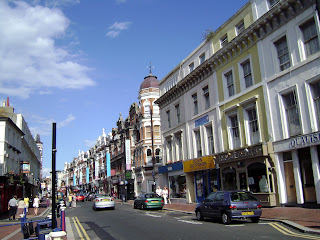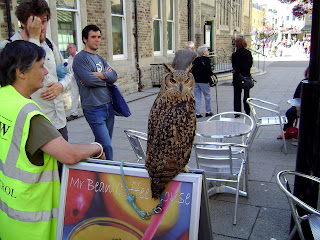Before going on our walk through Croydon, here is a little history.
The London Borough of Croydon was formed in 1965 from the old borough of Croydon and the urban district of Coulsdon and Purley. It is located on the southern edge of
London.
The areas that make up Croydon largely developed as 19th-century railway suburbs, but it had already been an established coaching town on the main road south from London long before.
By the 20th century Croydon had become an urban centre in its own right. After the Second World War it developed rapidly as a business centre with many companies moving from central London. The new town boomed and it became one of the most modern-looking centres in London with many office blocks, flyovers and underpasses.
One of Croydon's most important 20th-century developments was Croydon Aerodrome, which was established in 1915 to provide air defence for London. By the 1920s it had become the main airport for London and new buildings made it the most modern airport in the world. Croydon's small size eventually made it unsuitable for further development and Croydon rapidly declined as a commercial airport with the opening of Heathrow in 1946. Croydon Airport closed in 1959 and parts of the site have since been developed.
As well as being an important urban centre, Croydon has over 3,000 acres of parkland, countryside and open space within its borders.
I discovered Croydon because my son lived in Norwood for about 10 years. For years I used to go to Central London and walk around and shop there, but the last years I rather took the bus to Croydon and did my window shopping or shopping there. Croydon is a very nice town and has the same shops or shopping centers like in Central London. The only one which is missing is Harrod's but there you wouldn't go every day anyway. The shops are all in one big long street, where cars are not allowed and it is much easier to walk there than in Central London where the distances between shops or shopping galleries are very big.
This is the beginning of the long pedestrian area with the Whitgift shopping center, shops, boutiques, restaurants, cafés and pubs. The buildings left and right are old and mostly of victorian style.
The Elizabethan Whitgift Almshouses in the centre of Croydon
The Elizabethan Whitgift Almshouses, the "Hospital of the Holy Trinity" as it was named, have stood in the centre of Croydon (at the corner of North End and George Street) since they were erected by Archbishop John Whitgift. He had petitioned for and had received permission from Queen Elizabeth I to establish a hospital and school in Croydon for the "poor, needy and impotent people" from the parishes of Croydon and Lambeth. The foundation stone was laid in 1596 and the building was completed in 1599.
The premises included the actual Hospital or Almshouses, providing accommodation for between 28 and 40 men and women, and a nearby schoolhouse and schoolmaster's house.
Just besides the Almhouse is Allders the fourth largest department store in Britain after Harrods, Selfridges, and John Lewis (department store) in Oxford street. More about Allders'history you can find here.
All along the pedestrian area the original architecture is preserved, only the lower part is modernized.
There is always a nice ambience in this street, here is a baloon seller.
Isn't that a nice Burger King ?
The whole year around there are always a lot of people. At Christmas time the decoration is just wonderful in my opinion much better then in central London.
"THE OLD FOX & HOUNDS is a cosy little Pub where you can eat something or drink when you are tired of walking around.
And this is another which has amongst other good things, very good baked potatoes !!
In the middle of the pedestrian zone there are trees and flowers and many banks to rest
 An artist drawing on the street
An artist drawing on the street
Just an overlook how nice it is to shop here
A group of policemen walked around, they didn't bother anybody and nobody bothered them.
Buses from all parts of London are arriving here. If you take one at Oxford Street it would take you about 2 h to get to Croydon. Amazingly the buses are seldom late on schedule.
The modern part of Croydon with a lot of Offices, Insurance offices and Banks.
There are several high-quality arts venue.
The most important is the Fairfield Halls, opened in 1962, which consists of a large concert hall frequently used for BBC recordings, the Ashcroft Theatre and the Arnhem Gallery. The Halls are the home of the London Mozart Players. Many famous faces have appeared at the Fairfield Halls, from the Beatles through Bucks Fizz, omid Djalili, Robert Cray, Chuck Berry, Status Quo , Level 42, Joe Satriani, John Mayall, Jools Holland, Kenny Rogers, James Last to Coolio. The main concert hall was also used for the conference scene in the Tom Hanks film The Da Vinci Code.
I usually left the house in Norwood Junction around 11 am took the Bus and 15 min later arrived at Croydon's bus station. When I took the Bus to Oxford street it was a ride of a more then one hour. Of course by train/tube it went quicker, only 30 min but then you were sitting under ground a good part of the ride.
Yes, London is a very big city with around 14 million people. Its population is composed of a wide range of peoples, cultures and religions, speaking over 300 different languages.
Links to our Cyber Cruise





































































